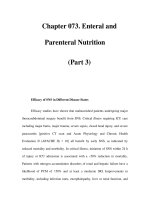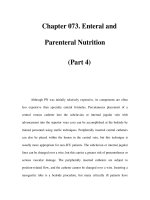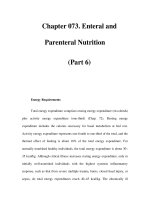Parenteral Nutrition
Bạn đang xem bản rút gọn của tài liệu. Xem và tải ngay bản đầy đủ của tài liệu tại đây (254.3 KB, 23 trang )
PARENTERAL NUTRITION (TPN)
What are the indications for TPN?
᭹
General critical illness:
Severe malnourishment with Ͼ10% loss of weight
Multiple trauma
Sepsis/multisystem failure
Severe burns
᭹
Gut problems:
Enterocutaneous fistula
Short bowel syndrome
Inf lammatory bowel disease
Radiation enteritis
Which is the absolute indication for TPN?
The most important indication is the presence of an entero-
cutaneous fistula.
How is TPN administered?
The high osmolality of the mixture causes irritation to small
vessels, so that it is generally given through a central vein,
e.g. tunnelled subclavian line. If it is to be given through a
peripheral vein, it must be given as a solution of osmolality
of Ͻ900 mOsm/l.
What are the basic components of a TPN regimen?
The basic components are water, carbohydrate, protein, lipid,
vitamin and trace elements. Various drugs may also be added,
such as ranitidine and insulin.
How is TPN monitored?
Monitoring involves nutritional status and biochemical markers
᭹
More than once per day:
Glucose
SURGICAL CRITICAL CARE VIVAS
P
PARENTERAL NUTRITION
᭢
171
P
PARENTERAL NUTRITION
᭹
Once per day:
Serum electrolytes
Urea and creatinine
᭹
Twice-weekly check:
Albumin and total protein
Calcium
Magnesium
Phosphate
Liver function tests
Why does liver function need to be monitored?
TPN can cause a derangement of the liver function tests sec-
ondary to enzyme induction caused by amino acid imbal-
ances. Also, it can cause fatty change of the liver.
What are the metabolic complications?
᭹
Hyper/hypoglycaemia
᭹
Hyperlipidaemia
᭹
Essential fatty acid def iciency
᭹
Hyperchloraemic metabolic acidosis: if there is an excess
of chloride
᭹
Hyperammoniaemia: if there is liver disease, or a
deficiency of L-glutamine and arginine
᭹
Ventilatory problems: with excess production of CO
2
if
too much glucose is used in the mixture. In the ventilated
critically ill patient, the amount of glucose given in 24 h
may have to be restricted to 5 g/kg
SURGICAL CRITICAL CARE VIVAS
172
PNEUMONIA
What are the normal respiratory defence
mechanisms?
᭹
Nasal humidification of inhaled air
᭹
Airway mucus secretion
᭹
Intact cough ref lex
᭹
Mucociliary action of respiratory epithelium
᭹
Alveolar macrophages
᭹
Secretory IgA
What is the definition of pneumonia?
Pneumonia is an inf lammatory condition of the lung char-
acterised by consolidation due to the presence of exudate in
the alveolar spaces.
What are the pathological types of pneumonia?
᭹
Lobar pneumonia: the exudate forms directly in the
bronchioles and alveoli and spills over into adjacent
segments via the pores of Kohn. The consolidation is
sharply confined to a particular lobe. It is typically
pneumococcal in origin
᭹
Bronchopneumonia: the inf lammatory process starts at
the bronchioles and extends to the alveoli, leading to
numerous foci of consolidation. It is more common at the
extremes of age, and in those with chronic illness
᭹
Interstitial pneumonia: consists of a group of conditions
characterised by chronic alveolar inf lammation, which are
not necessarily infective in origin and may have an
immunological basis
What are the classical pathological phases of lobar
pneumonia?
There are four pathologically recognised stages
SURGICAL CRITICAL CARE VIVAS
P
PNEUMONIA
᭢
173
P
PNEUMONIA
᭹
Acute congestion (day 1–2): the lobe is heavy, dark and
firm with inf lammatory exudate and cellular infiltrate,
including erythrocytes
᭹
Red hepatisation (day 2–4): the lung is firm, red and
consolidated. The alveolar spaces contain neutrophils,
fibrin and extravasated erythrocytes
᭹
Grey hepatisation (day 4–8): the lobe is heavy, consolidated
and grey. There is an extensive f ibrin network with
degenerating erythrocytes
᭹
Resolution (Ͼday 8): macrophage action liquef ies the
exudate with fibrinolytic enzymes. Full resolution may
take up to 3 weeks
How common is pneumonia in the ITU and which
organisms are involved?
Nosocomial pneumonia in the ITU may occur in 30–40% of
ventilated patients and 15–20% of the unventilated.
Ventilator-associated pneumonia may be divided into early
onset (1–4 days following intubation) and late onset (beyond
day 4).
Organisms involved
᭹
Early onset: Oropharyngeal organisms mainly
e.g. Strep. pneumoniae, Staph. aureus (including MRSA),
Haemophilus influenzae
᭹
Late onset: Usually involving Gram negative organisms,
e.g. Pseudomonas spp., Enterobacter, Acinetobacter
What are the risk factors for nosocomial pneumonia
in the intubated patient?
᭹
Loss of anatomic barriers due to instrumentation: organisms
can enter the lower respiratory tract when the epiglottis and
glottis are breached by the endotracheal tube
᭹
Impaired cough ref lex: as the endotracheal tube opens the
glottis
SURGICAL CRITICAL CARE VIVAS
᭢
174
᭹
Re-intubation
᭹
Colonisation of other instruments, e.g. tubing in the
ventilator circuit, and Y-connectors for tubing
᭹
Aspiration of gastric contents which may be colonised by
bacteria
᭹
Prone positioning predisposes to aspiration
᭹
Epithelial trauma to the airway, e.g. by suction devices
᭹
Cross colonisation from staff and other patients
᭹
Generalised debilitating or chronic illness, e.g. malignancy,
diabetes mellitus, burns, general trauma, and uraemia
Which factors predispose the stomach to bacterial
colonisation?
The risk of bacterial colonisation increases when the gastric
pH Ͼ 4.0
᭹
Use of H
2
-blockers to prevent stress ulceration
᭹
Continuous gastric feeding
᭹
Chronic atrophic gastritis leading to achlorhydria
How is pneumonia recognised in the ITU setting?
The ‘Gold Standard’ for the diagnosis of pneumonia in the ITU
is direct biopsy of suspected lung tissue, but this is not ideal.
Many of the clinical features are common to a number of
conditions, such as atelectasis.
Features include
᭹
New or progressing pulmonary inf iltrates
᭹
Pyrexia Ͼ38°C
᭹
Leucocytosis Ͼ14,000
᭹
Purulent tracheal secretions
᭹
Positive Gram staining and cultures in the light of these
changes
᭹
Specimens may be collected by:
Bronchio-alveolar lavage
Brushing
SURGICAL CRITICAL CARE VIVAS
P
PNEUMONIA
᭢
175
P
PNEUMONIA
Trans-thoracic needle biopsy
Open/video-assisted lung biopsy
How can pneumonia be prevented?
Prevention is always more effective than prolonged antibiotic
treatment. This involves
᭹
Protective isolation of high-risk patients
᭹
Control of cross infection by staff, e.g. hand-washing
᭹
Intermittent, and not continuous enteral feeding
᭹
Controlled use of antibiotics to prevent multi-drug
resistance
᭹
Use of sucralfate for stress ulcer prophylaxis
᭹
Suctioning of sub-glottic secretions
᭹
Decreasing the number of times that the ventilator circuit
is ‘broken’ by connections
What are the complications of bacterial pneumonia?
Complications include
᭹
Pleuritis: leading to pleural effusion and healing with
extensive adhesions
᭹
Empyema: a loculated collection of pus in the pleural
cavity surrounded by a fibrinous wall
᭹
Lung abscess formation, which can erode to form a
broncho-pleural fistula
᭹
Metastatic abscesses, e.g. cerebral abscess
᭹
Generalised sepsis
SURGICAL CRITICAL CARE VIVAS
176
PNEUMOTHORAX
What types of pneumothorax are there,
and what are their identifying features?
There are three types of pneumothorax
᭹
Simple pneumothorax: where there is air in the pleural
space, but no cardiovascular compromise
᭹
Tension pneumothorax: there is a one-way valve effect
that allows air to enter the pleural space, but not to leave
it. Mediastinal shift and compression from the air in the
pleural space displaces the heart and great vessels,
producing cardiovascular compromise and shock
᭹
Open pneumothorax (‘sucking chest wound’): an open defect
in the thoracic wall draws in air during the respiratory
cycle, leading to tension pneumothorax
Note that a simple pneumothorax, if left unmanaged may
lead to tension pneumothorax when large enough to cause
mediastinal shift.
What are the causes of pneumothorax?
Some causes are
᭹
Spontaneous pneumothorax: following the rupture of
apical blebs of unknown origin. Also occurs more
commonly in asthma, cystic fibrosis, or associated with
bullous disease in COPD
᭹
Traumatic: with both blunt and penetrating chest injury
᭹
Iatrogenic: e.g. following pleural aspiration, central line
insertion, oesophagoscopy and barotrauma from IPPV
What are the signs on clinical examination?
For simple pneumothorax:
᭹
Ipsilateral reduction of chest wall movements
᭹
Increased resonance to percussion
᭹
Reduced breath sounds
᭹
Occasionally, the presence of subcutaneous emphysema
᭹
Tachycardia: a non-specific sign
SURGICAL CRITICAL CARE VIVAS
P
PNEUMOTHORAX
᭢
177
P
PNEUMOTHORAX
With tension pneumothorax, there is the above, together
with
᭹
Tracheal deviation indicating mediastinal shift to the
opposite side
᭹
Hypotension
᭹
Elevated CVP
᭹
Cyanosis despite tachypnoea
How may pneumothorax be recognised in the
mechanically ventilated patient?
᭹
Sudden increase in the inf lation pressure
᭹
Sudden and unexplained hypoxia
᭹
Development of a new cardiac arrhythmia, such as atrial
fibrillation
᭹
Sudden hypotension or rising CVP
How is the diagnosis of pneumothorax confirmed?
A chest radiograph taken during expiration conf irms the
diagnosis. Tension pneumothorax is a clinical diagnosis that
must be managed by life-saving chest decompression before
waiting for the radiograph to confirm.
How is pneumothorax managed?
᭹
All types require the airway to be secured, together with
administration of 100% oxygen by face mask
᭹
Tension pneumothorax is managed by emergency needle
decompression
᭹
Ultimately, chest tube thoracostomy is required once the
tension has been converted to a simple pneumothorax
following decompression. This also drains blood in
traumatic cases
᭹
For an open pneumothorax, an occlusive dressing is
applied to the surface of the wound, being taped down on
three sides. This acts as a one-way valve, allowing air to
escape on expiration, and preventing air entry on
inspiration
SURGICAL CRITICAL CARE VIVAS
᭢
178
᭹
Recurrent cases of spontaneous pneumothorax may be
managed by open or thoracoscopic pleurectomy. By
stripping the parietal pleura, adhesions form between the
lung and chest wall, preventing further collapse
How is emergency decompression of a tension
pneumothorax carried out?
᭹
The patient is administered 100% oxygen
᭹
A large bore (14 or 16-guage) needle is inserted into the
2nd intercosal space in the mid-clavicular line. It must
pass along the upper border of the third rib to prevent
injury to the neuro-vascular bundle
᭹
The correct position is confirmed by the presence of the
hissing sound of escaping air
᭹
A chest tube thoracostomy is prepared for definitive
management
SURGICAL CRITICAL CARE VIVAS
P
PNEUMOTHORAX
179









